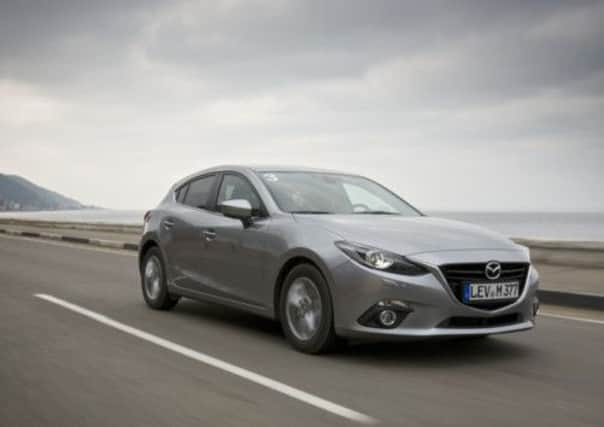Driven slightly mad in a Mazda


“Oh, meant to say,” he casually added, “you’ll actually be driving the car the best part of 1,200 miles. Over three days. In Eastern Siberia. On some of the most demanding, challenging and unrelenting roads in the world.” That put a slightly different perspective on things, but it definitely made it even more of an adventure: how could I say no?
To mark the launch of the new Mazda3, it’s driving eight of the new models from the factory at Hiroshima in Japan — having been ferried to Vladivostock — to next month’s Frankfurt Motor Show where the car will be officially unveiled. As the only Scottish motoring journo, and one of just a handful of UK scribes to be invited, I had control of the car for the 1,200 miles from Ulan-Ude to Krasnoyarsk.
Advertisement
Hide AdAdvertisement
Hide AdOver four days, with a rest day included, I spent an average of 14 hours in the car, so it’s fair to say I got a pretty good feel for the new Mazda3. But this was no ordinary road trip.
Within 3 miles of leaving Ulan-Ude there were cattle strolling across what is the main A-type road east out of the city. Minutes later there were horses standing stationery in the middle of the carriageway.
And potholes? Forget anything you’ve ever thought about what we have in the UK: these were serious potholes. I honestly believe there were some big enough to lose teenage children down, they were so deep.
I’ve also never seen so many cabbage fields: they stretched to the horizon. I’d heard about Russians and their love of cabbage, but this was cabbage-farming on an all but unimaginable scale.
It also quickly became clear that health and safety was a subject taken to the other extreme in Siberia from the namby-pamby approach seen in the UK.
When the Russians decide to re-lay the tarmac on one carriageway of an A-class-type road, they just get on with it. A truck with a trailer full of tar, a road-roller and five guys — one with a brush — is all that’s needed. No bollards, no flashing lights, no average-speed cameras, not even a hi-vis jacket in sight.
What was also obvious, once we got into the countryside, was that the housing is bleak, dismal and dilapidated. The homes are either single or two-storey, thin wooden-built dwellings with corrugated iron roofs, but most of them look as if they’re from another time. Nothing seems to have changed here for 200 years. Let’s say that it’s basic.
How basic? Well, without getting into too much detail, the toilet facilities at one of the restaurants where we stopped for lunch consisted of a large wooden hut perched on the side of a hill. Inside there was no light — so you were thankful the flimsy door didn’t close properly — and a two-foot-square hole cut out of the wooden floor. Enough said.
Advertisement
Hide AdAdvertisement
Hide AdNow, remember this “facility” was only 20ft from the restaurant. A colleague pointed out to me later that what went into the hole in the wooden floor was then left to make its own way down the hillside under its own steam.
Much of our route took us along the side of the famous Trans-Siberian railway line. On one occasion we were stuck at a railway crossing for 45 minutes as six goods trains — each hauling 86 tankers — trundled wearily past.
Road conditions vary enormously too. Travelling hundreds of kilometres through seemingly never-ending forests — Russia accounts for one-seventh of the world’s land mass, but supports 25 per cent of global forests — we switched from billiard-table smooth roads to gravel tracks with boulders the size of footballs.
And there was no warning. Suddenly the tarmac would just stop, and that would be it: you’d be crawling along at a snail’s pace for 30 miles on loose gravel dodging suspension-shattering potholes.
One night was spent in Listvyanka on the shore of Lake Baikal. Now, there are lakes, and there are lakes. This lake is the biggest fresh water lake in the world. It holds 20 per cent of the world’s fresh water, and 90 per cent of Russia’s fresh water.
It’s volume is larger than that of the Great Lakes in America put together; it’s almost 400 miles long, 50 miles wide, 1 mile deep, and it freezes completely in the winter when temperatures plummet to - 40C.
In contrast, the day I was there it was 32C and the Siberians were walking about bare-chested, mirroring the hardman image of Russian president Vladimir Putin.
And then there was the food. This is one of the poorest areas in Russia, and the people struggle to put any form of meat on the table, so vegetable soups were the order of the day… and the next day, and the next.
Advertisement
Hide AdAdvertisement
Hide AdOccasionally there was meat, in some form. In an act of self-preservation, generally I declined. The benefit of that was, unlike the majority of the other guys on the trip, I didn’t suffer from the excruciating dicky tummies: not what you want when you’re spending hours in a car.
I survived on a mix of soups, fun-sized Snickers and Mars Bars from the Mazda support car, and 450ml tins of Red Bull. Oh, and regular use of my anti-bacterial gel.
People have said I was mad doing this trip, but I’d contest that. It was a unique experience, unforgettable, and completely unrepeatable.